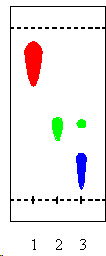
General Announcement (Please read!)
1. It has come to my attention that some students are not clear about certain policies in this course. There is no such policy in this lab course which discourages students from asking questions. The reason why you are here is to learn. This should also result in questions from the the student's side, which are welcome by the teaching assistants and the instructor. However, it is expected that the student comes prepared to the lab section in order to be able to complete the experiment in a timely fashion. The majority of the questions regarding the experiment (theory and practical issues) can be answered during lecture and office hours. A question also should demonstrate the student's ability to analyze the problem and be as specific as possible in his/her inquiry. A simple comment like "I don't understand this" is not particularly helpful for the person that you are asking since they do not know which part you are having problems with.
2. In the future, please do not study outside my office (YH3077E). My colleagues in the office suite try to get some work done, and the noise outside is rather disturbing i.e. cell phones, etc. The tables in the office suite are reserves for office hours, etc.
ATTN: answers to the below questions are due at the start of your lab period; these answers should be part of your pre-lab write-up.
1. Referring to the Aldol reaction carried out in the lab, answer the following questions. Show pertinent equations where appropriate.
a. Why is it imperative to minimize the amount of water in the system? How is this accomplished?
b. Why is it important that both ketones are dissolved before the KOH solution is added?
c. Which observations will the experimenter make during the reaction if everything is going according to plan?
d. A student obtained 0.240 g (dry weight) of the crude product. How much solvent should he use to recrystallize the crude product?
e. A student used boiling stones for the recrystallization. Which problem does this pose?
2. A student isolates 800 mg g of a crude product Z that shows the following solubilities (in g/mL) in absolute ethanol, ethyl acetate and hexane. The impurity to be removed is weakly polar.
| Temp (oC) |
EtOH
|
EtOAc | hexane |
| 0 | 1 | 1 | 6 |
| 20 | 2 | 3 | 7 |
| 40 | 3 | 5 | 8 |
| 60 | 4 | 7 | 9 |
| 80 | 5 | 9 | XXX |
a. Which solvent should the student use for recrystallization? Rationalize your choice.
b. Assuming the recrystallization is carried out correctly, how much of the pure product would be recovered? Show your work.
c. Why is it important to allow the solution to cool down slowly during the recrystallization step?
d. Take the online quiz for recrystallization below prior to the 5th meeting.
http://bacher.chem.ucla.edu/TakeQuiz/?id=aab3238922bcc25a6f606eb525ffdc56
3. While running the following reaction
A + B --> 2 C
a student acquires a TLC for his reaction mixture using a plate coated with silica and a mixture of diethyl ether and hexane (1:1) as eluent. He observes the following result

Note: Lane 1 is compound A, lane 2 is compound B and lane 3 is the sample from the reaction mixture.
a. Determine the Rf-values for all compounds.
b. What can be said about the progress of the reaction?
c. Why are a lot of the spots so large? How can this be prevented?
d. How would the TLC result change if the experimenter would only use diethyl ether as solvent?